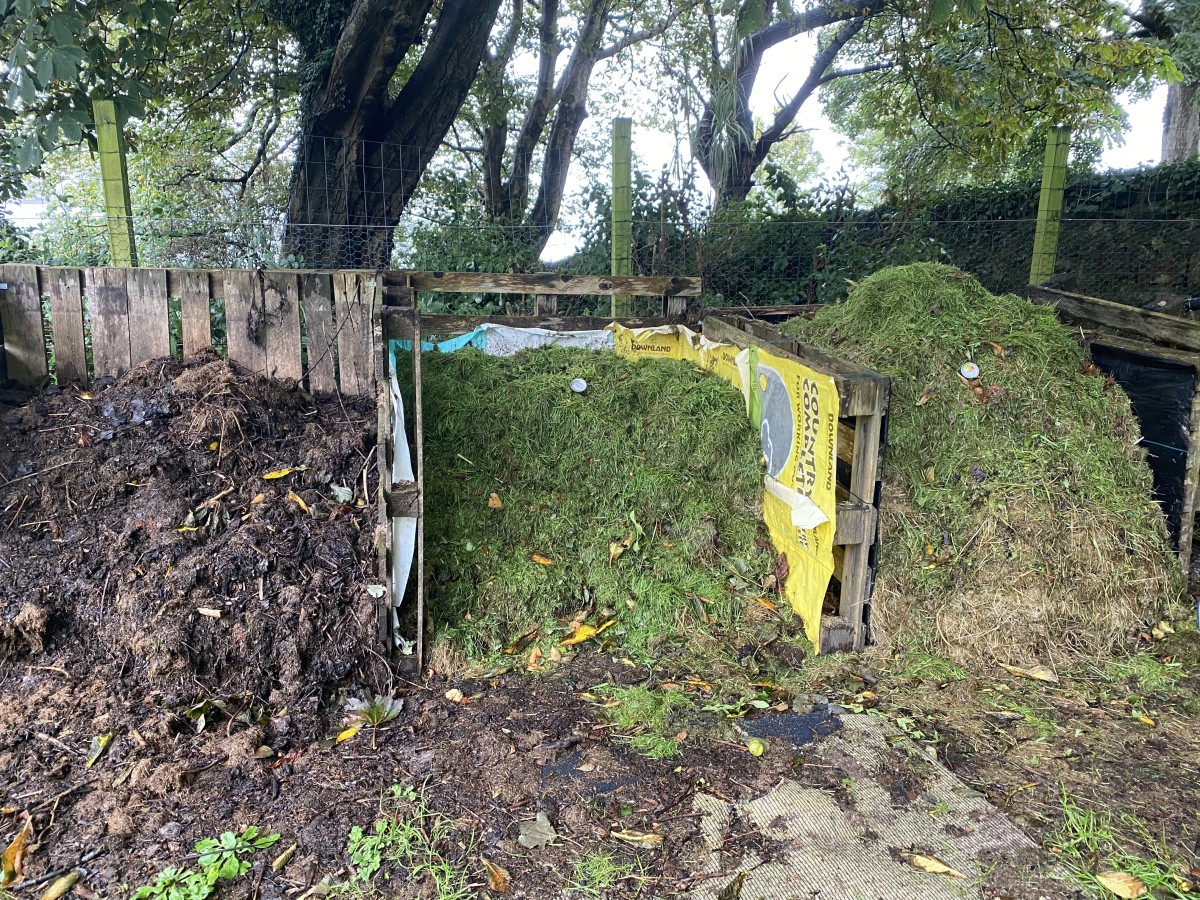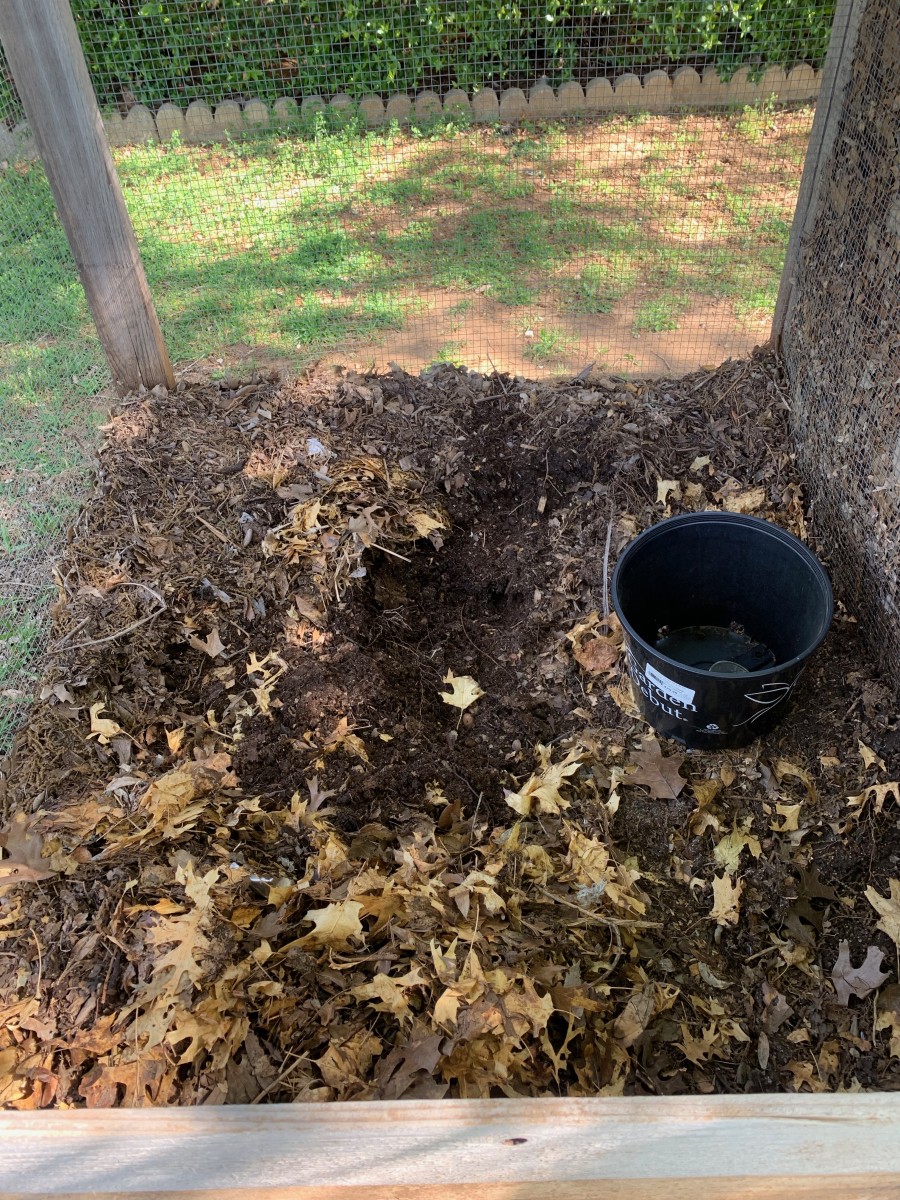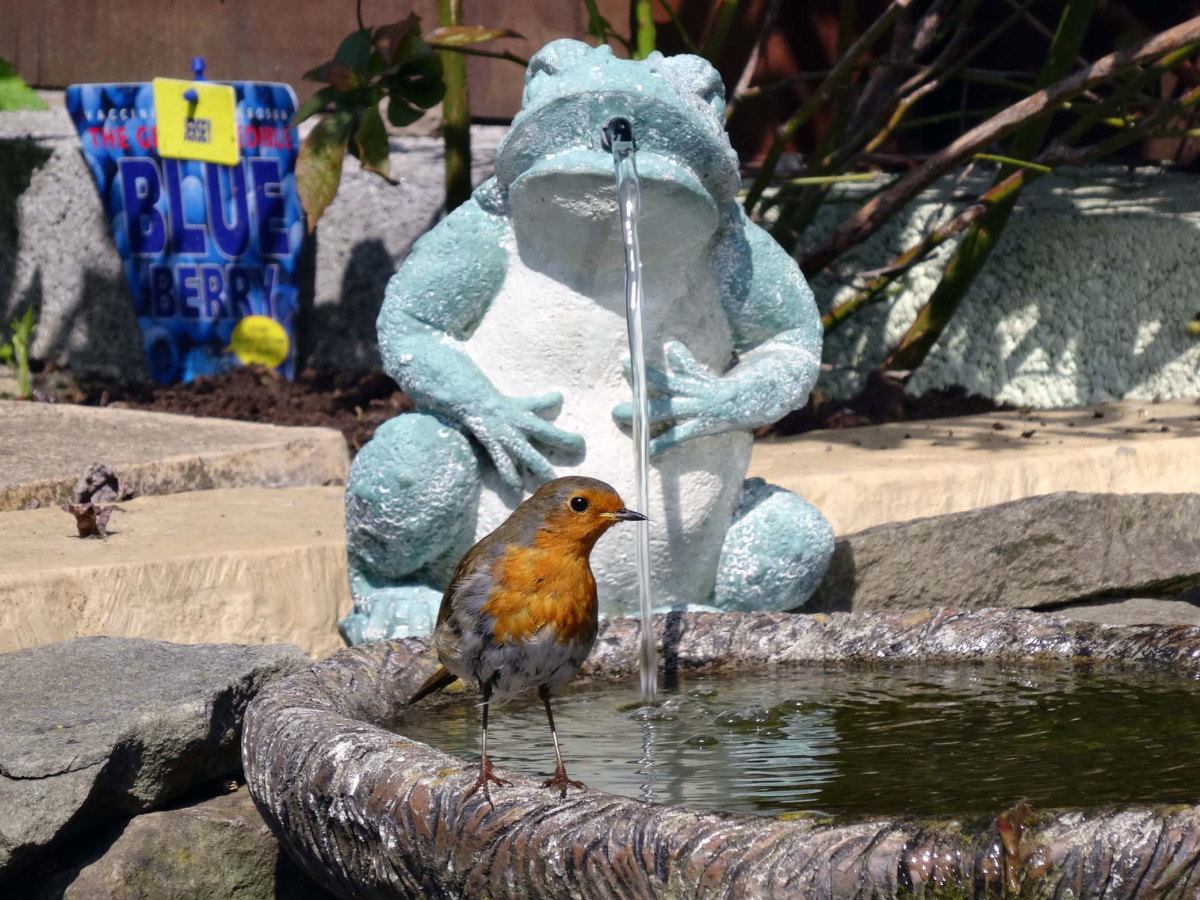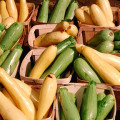Green & Brown in the Compost Bin When You're Short on Green: Now With Audio Version!
Living by the ocean means not much grass to mow!
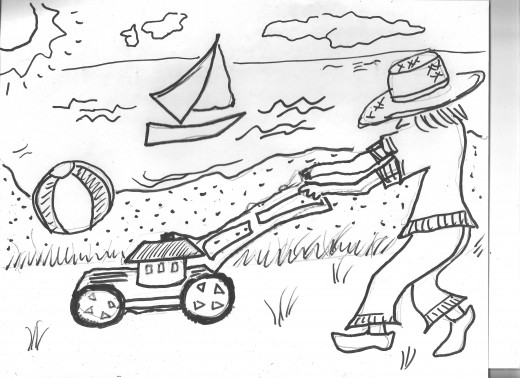
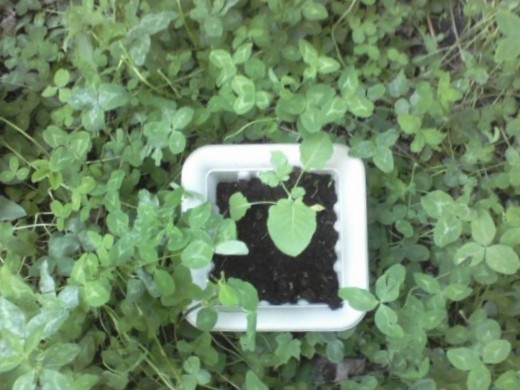
Alternate layers of brown and green
Ideally, a compost pile would have twice as much green as brown. This has to do with carbon's presence and its interaction with nitrogren. Even when plant materials have needed minerals in them, the trick is to get the nutrients into a usable form. (This is why people add inoculant when planting beans, as a "nitrogen-fixer.") When carbon and nitrogen work together, a large amount of materail in a compost pile can break down quickly. The resulting compost is high-quality: moist, dark, crumbly, and free of former impurities which have now been "cooked" out of it.
This Hub, as in others I've contributed, is about how to garden in less-than-ideal circumstances. I just don't have enough green matter to make up two-thirds of the pile. Back wen I lived in the Midwest, this was no problem, as lawn clippings were easy to get. All I had to do was mow lushly growing grass, which seemed to get taller by the minute.
But I live near the ocean now, and while it's beautiful and I'm glad I moved, there just isn't all that green, green grass of home. Here, a few blocks from Casco Bay, the air is salty, the temperatures are cool, and the soil is sandy. What we have for grass is a tough, tufty beach-y grass that I'm digging up and replacing with perennials anyway, as it's so hard to mow. Also the houses are close together in New England, with little postage stamp lawns and not the half-acre lots you see everywhere in roomier spaces. So I can't just do what I used to do in Ohio or Indiana: take the bag off the back of the power mower and dump it over the leaves I raked up last fall.
Not only do I not have enough green, I have way more brown than I need. As my starting point, I have three times as much brown as green. What I lack in grass clippings, I have in fallen maple leaves. Trees yes and lawn, no. I do love trees and it's not that I want a lawn anyway but that's a discussion I've already brought up in another Hub.
So today I'm writing about how I do my best to make up the difference in green and brown ratios so that my carbon-nitrogen mix is closer to optimal and my compost is of better quality.
Fore! Doesn't this grass whip look like a golf club?
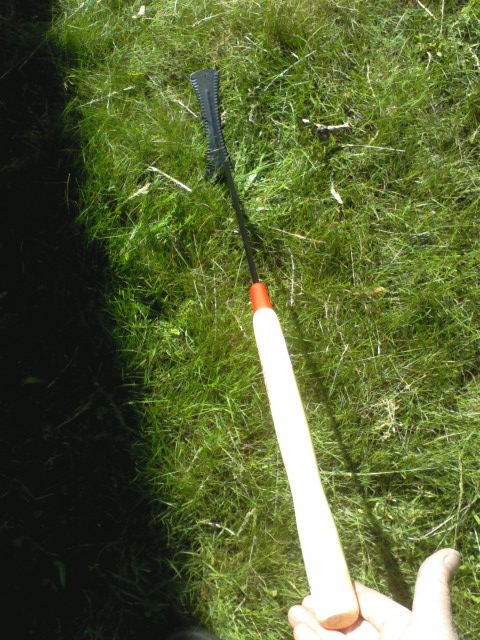
Down with the brown, up with the green
For a better ratio for the compost, I need to do something with the brown leaves besides put all of them in the compost pile. Yes, the city will take bagged leaves once a year if I put them out on the right day, but then I would have to buy the bags -- I don't want to do that -- and then put the leaves into the bags -- I don't want to do that either. And my goal is to make our life, including the gardening and food production and eating of that food more of a self-sustaining circle. I want to take what we already have, upcycle it into a higher-level resource and use that to create more of what we need here.
But there's only so much I can do with all the brown leaves. So once those are repurposed in the ways described later in this post, my next step is to find new sources of green. I could go outside the Tiny Maine Homestead to seek out what I need but again, I want to use what I have. I've written another Hub on the topic of "green manure" made from cover crops, and these plants are he type of material I add to the compost pile to bring the brown/green ratio into better proportions.
Using brown leaves to fill the basil pot
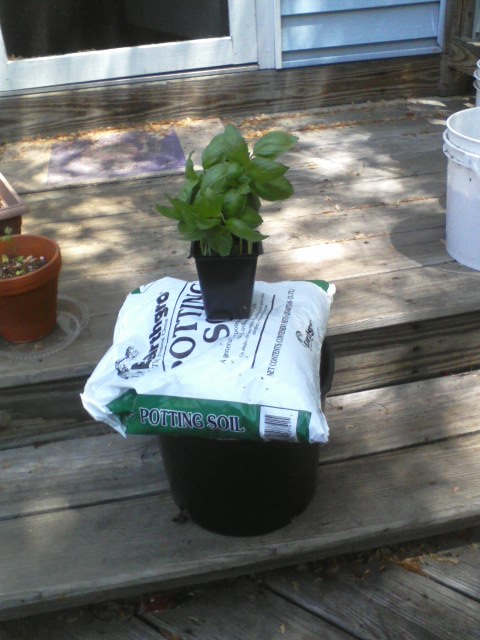
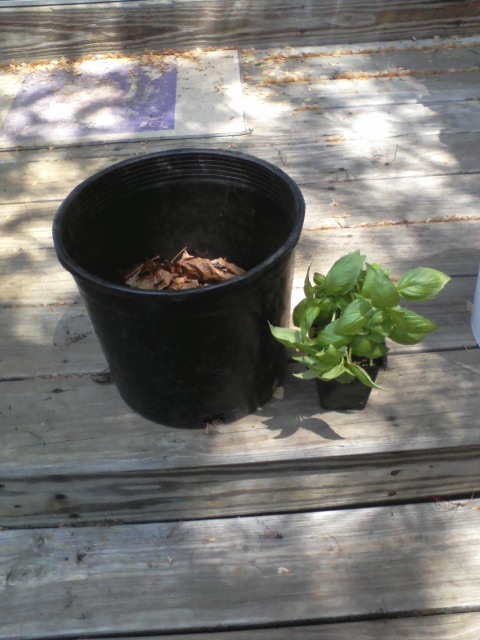
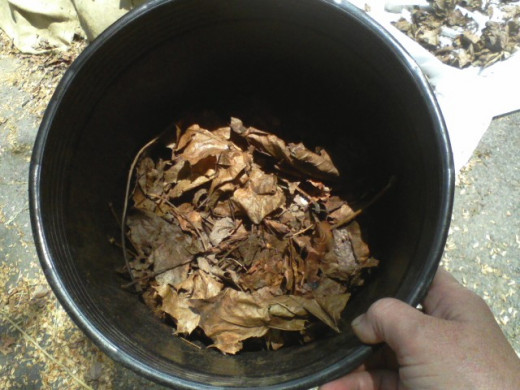
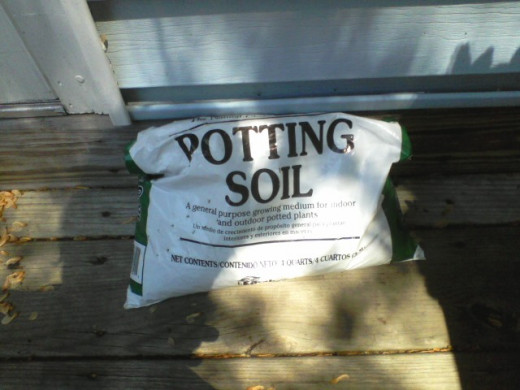
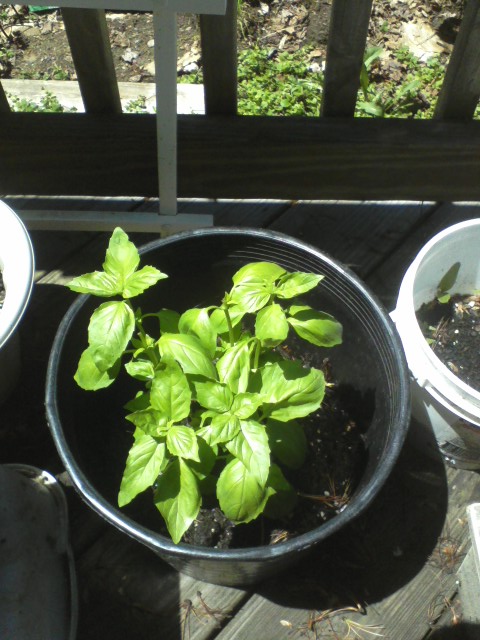
Too much brown? Not sure what to do with it? Idea #1
On television gardening shows, the people doing the how-to segments always have the correct size container for whatever vegetable or herb or flower needs repotting. In my actual life, that only happens maybe half the time. I often find myself putting a rootbound plant or a new seedling into a contaainer too deep for it, as my other option is to use one that's too small or too shallow and that wouldn't do at all.
In the past, I have filled the container with potting soil, which works but has the double problem of wasting money (dirt is not really dirt cheap, is it?) and wasted soil that's down below roots that will never reach it. And wasted soil means soil I had to buy, carry, mix, trowel in, all that.
My solution is to use brown crunchy leaves from the top of the compost pile as volumizer in the bottom of the oversize pot. The leaves are springy, porous, cost nothing, and are lighter than the soil mix would be, so the planter, when full, is not so heavy.
Idea #2 for too much brown
Another thing brown leaves can do is to help make "dirt lasagna." For this soil-building technique, unlike using the leaves as pot fillers, the uncomposted material works best when wet. So before I begin layering my extra maple leaves between layers of dirt, mulch, and cardboard, I turn the garden hose on the leaf pile or dump the leaves into a plastic bin and pour in a couple five-gallon icing buckets full of water.
My beans are planted in a no-dig garden bed I made my layering wet brown leaves, wet brown cardboard, and a mix of soil and black crumbly compost from the bottom of my bin. The beans are flourishing. Over the next couple of growing seasons, I will add more layers of leaves, compost, and cardboard to deepen the soil mix created by the "lasagna" method so I can grow root crops in this bed.
Using brown leaves idea #3: as a loose mulch
I don't like to weed corn. I have three small garden plots on our Tiny Maine Homestead, and one of them is a raised bed I built on part of our driveway. Two of the plots have corn planted in long rows, as is done in the traditional method. But in the raised bed, a large square which is about five feet on each side, I spaced the corn plants a foot apart from each other in each direction, a little like the way you lay out your three rows of checkers when you are about to begin playing the game. In this raised bed, I have the corn planted in about a foot and a half of soil mix and then I mulched around the cornstalks with another six or eight inches of brown leaves. So far I've used a couple bushels of leaves, and as the corn grows taller and as rain compacts the leaf mulch, I will add another bushel or two (or three).
Corn helps me in one of two ways
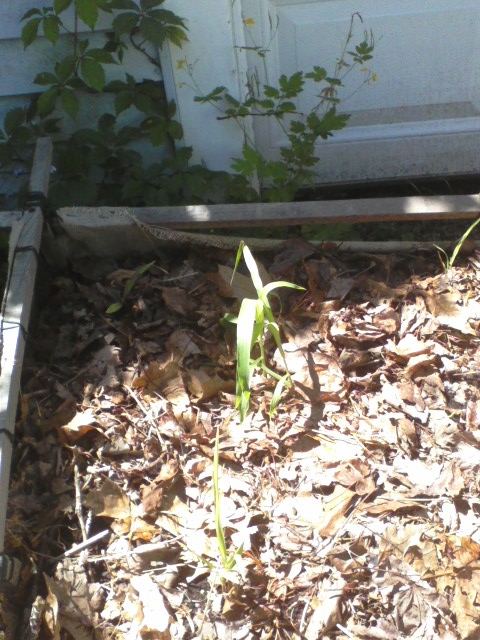
More green in your. . .well, not in your pocket.
That would be silly; your pocket's not big enough, at least on the literal level. How much green compost could you fit in there? Of course, on the metaphorical level, if you can get your level of green compost up to twice the level of brown compost, and without spending much money, then the pocket idea makes sense.
The main sources for the supplemental green layer I need for the compost bin are various forms of ground cover crops. I have two main ones I use. When it comes to saving money, both are a good deal. Clover seeds itself and comes back for several years without me having to buy more clover seed. Buckwheat does need to be re-seeded annually but it makes lots of kernals at the top of each stalk, and these kernels are the seeds I plant. They are so easy to havest and remove from the stalks that I can have all the buckwheat seed I need for the following year in about fifteen minutes, including the first step of pulling up the buckwheat plants all the way to the final step of putting the hard dark three-sided kernels into an upcycled junk mail envelope and labeling that "Buckwheat" with the current growing year. All that in a quarter hour. Done. And no money laid out after the first planting of buckwheat seed.
Clover is a great cover crop
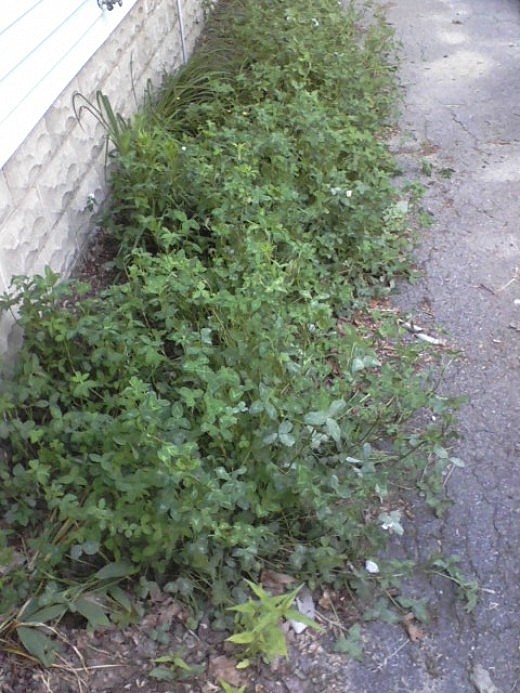
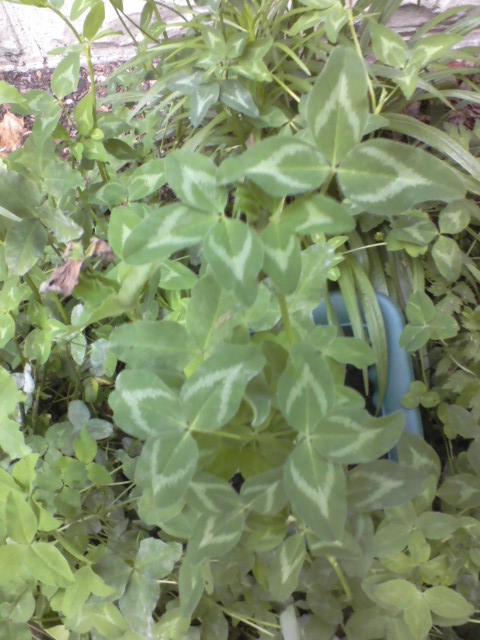
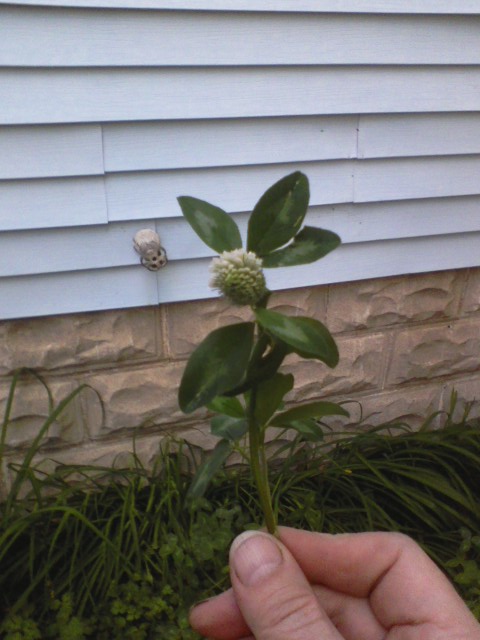
Cut clover added as a green layer
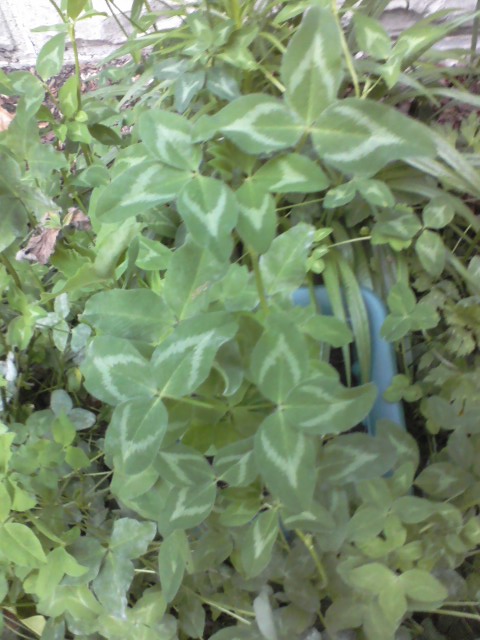
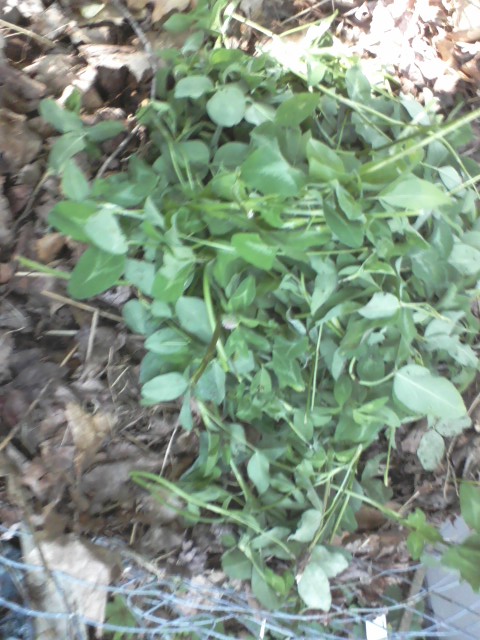
Buckwheat does double, triple, even quadruple duty
Buckwheat is not a grain, but it looks like one. It is fast-growing, not picky about growing conditions, and it makes pretty flowers. It produces plenty of grain-like seeds I can save to plant the following year, and it helps the soil hold nitrogren. When planted thickly, it will crowd out weeds.
If I need the kernels, I wait till the end of the growing season and pull the plants up in late summer. But if I want to use the space for fall crops, I can pull the buckwheat up any time and toss the green stalks onto the compost pile for an excellent green layer, and then plant something else right where the buckwheat grew an hour before.
Buckwheat is useful and nice to look at
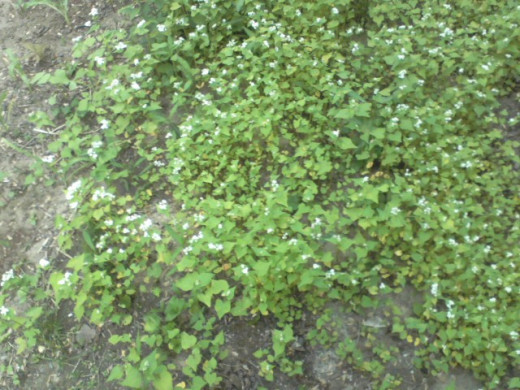
Corn helps me a second way by growing in my attic!
I had leftover seed corn this year. I saved four or five ears from last year, and after I had all the plantable space filled with sweet corn, there were still a few dozen kernels left. I don't have backyard poultry -- yet! I hope to raise chickens next year -- so here I had this soaked corn and I decided to use the light at the ends of my attic. Under each set of eaves, there are two medium-sized windows in our 1930s cottage-style home.
I planted the corn in white plastic dishpans from the dollar store (I often use these as contaiuners to grow culinary and medicinal herbs) as well as cardboard lids from copier-paper boxes. The little corn plants got to be about six or eight inches tall with nice bright green leaves. I watered them daily and when they got as large as they could get in the shallow containers, I uprooted them and added them as a green layer to the mesh cylinder filled with my mostly-brown compost.
Corn leaves for the green layer
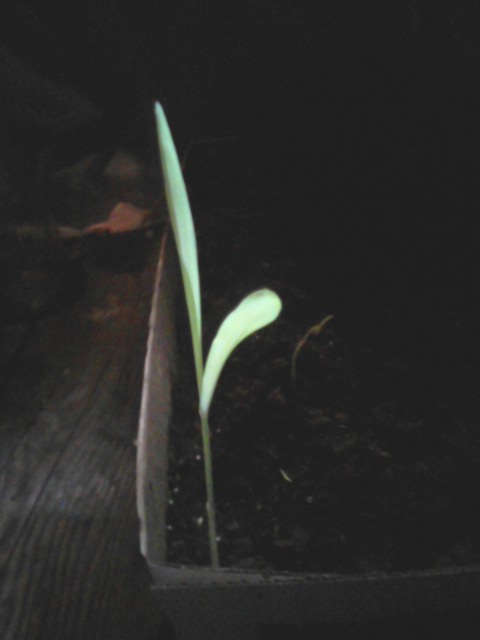
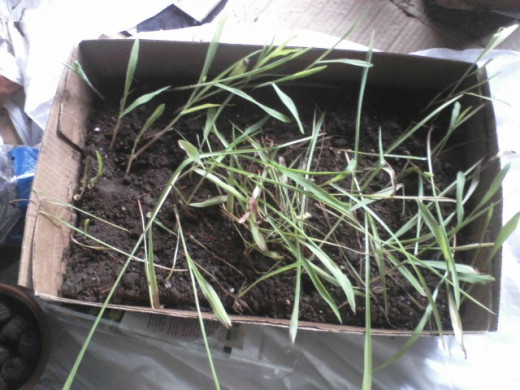
Compost in a free pile vs. in the hardware cloth cylinder
Here at the Tiny Maine Homestead, there are five -- count 'em, five! -- compost areas. There's a "wet" compost bucket with a snap-down lid, and that holds vegetable and fruit peels and egg shells and other food scraps that skunks, raccoons, and dogs would like to get into.
There's a second commercially-made plastic bin, also with a lid, near the back fence. That one has food scraps which are more dry and have less food sugar or odor which wuuld atrract the furry creatures -- into that bin go the tough broccoli stems, rubbery outer leaves from heads of cabbage, things like that.
Then there's the free pile of compost, which is a spot near the shed behind our garage. This is where I pile "bad" compost, meaning mostly weeds. I do want the benefit of the green leaves, but I don't want the seeds from those weeds to germinate with the good compost. By piling this green matter in a cone-shaped heap right on the warm ground, I am taking away any ventilation and letting the sun's heat soak into the weed leaves and stems, all matted together and then matted to the ground, where the warm soil will continue to "cook" the compost for an hour or two after the sun goes down each summer night. The intense heat in the pile will be too much for the weed seeds, and they won't be likely to grow when the wilted green mass is added to make a green(ish) layer in the "good" compost.
The fourh compost pile is the central compost area, and it's where all the other compost will eventually go when it "finishes" in one of the other piles. This pile is silo-shaped, and it is formed inside a cylinder I created by rolling a section of hardware cloth (like cicken wire, but sturdier, with rectangular openings) into the cicrumference I wanted. I fastened the cylinder together with plastic cable ties. I can snip the ties with scissors and re-form the cylinder if I want it larger or smaller in diameter. There's no bottom to the cylinder, so when it's full I can just pull the whole thing straight up and move it to a new location to start a new pile. Or I can use a garden fork to lossen the pile and then re-fill the cylinder in its new spot, taking what was on the top and putting it on the bottom and continuing until the uncomposted stuff from near the bottom of the old pile is now on the top. The very bottom layer is the completely composted stuff, black and crumbly, and it's ready to add to the garden soil.
The cylinder is where I put the brown and green layers of "parfait" to make the finished compost. It does not get as hot as a pile on the ground does, because the crinkly leaves in the brown layer are looser and let some air though. When it rains, the leaves get wet and stick together more, so the pile moves down, but overall the pile does not heat up as much as the pile on the ground. Since I have all that brown stuff to move through the system. I "salt" each brown layer with Compost Quick, which is a granular microbial product you can buy at the hardware store or lawn and garden center. The microbes help the good bacteria break down the leaves into compost faster.
Which is good, because my fifth compost pile is brown overflow. I don't want to put all brown into the cylinder. because I need to put green in between, and sometimes I don't have green at the moment. So there's always a pile of brown leaves raked up against the backyard fence, like people outside a sold-out concert, searching for ticket scalpers. If I bagged the brown leaves in black trash bags and added some more Compost Quick, they'd break down faster. But then I'd have to do all that, and also I am not sure I want the black plastic chemicals to leach into the compost. So I rake all that brown into a pile next to the stockade fence and wait for the green to come in, like the Thursday night before payday.
"Naughty" vs. "Nice" compost -- no weeds got in the wire bin
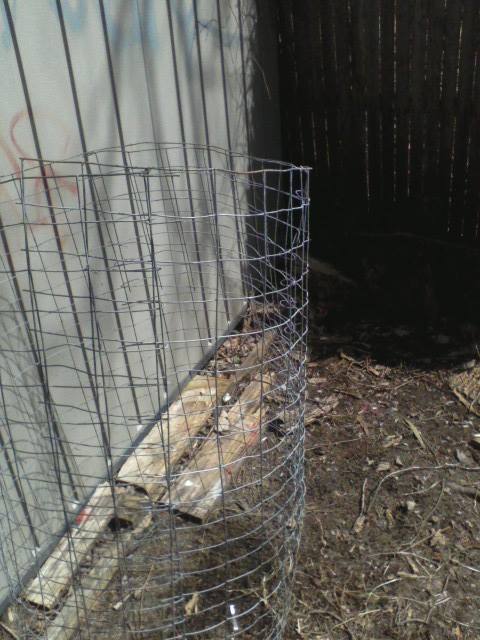
Weeds in the green layer -- yes or no?
No! Well, not right in the green layer directly. I don't want to germinate the seeds in the weeds I pulled up and mix them in with soil around my garden plants. That would be seeding my garden with weeds the way someone might plant a lawn.
Instead, I compost green weeds in a separate pile. When the weeds have deteriorated in the sun, and heat from the pile has made most of the weed seeds unviable, then I am willing to put the green "bad" stuff in with the rest of the "good" compost.
Green manure or green fertliizer in the pile
Link to rye article
"Bad" green compost turning good
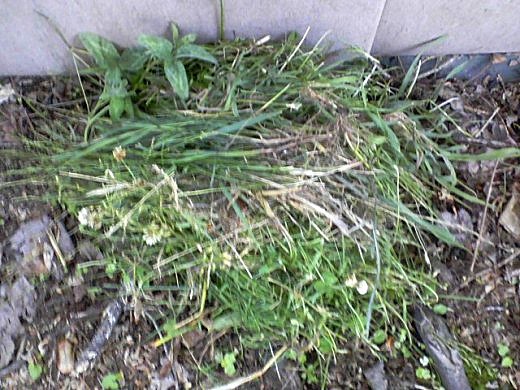
Making up the difference with kelp powder
We live on a small lot and there's only so much space for cover crops like clover and buckwheat for my green compost / fertlizer needs. And I have so many brown leaves that even I, creative soul that I am, can't think up enough uses for all of them. So my brown/green radio will always favor brown, and I need a work-around.
I have a foil bag of kelp powder I got to make a seed-germinating solution, and I am thinking of adding some of this to the brown layers in the compost pile. Kelp is rich in nitrogen. When the compost is done, I will be adding worm castings so the overall soil mix will have plenty of nitrogen for the plants, but I hope that the kelp might help bring the carbon-nitrogen balance in the compost pile closer to the ratio where the materials break down both well and quickly.
Have the opposite problem? Way more green than brown?
When I lived in Ohio, I had more green compost than brown. The lawn at my rented apartment grew lushly, and I had a larger garden then with a lot of green plant stalks from tomatoes and peppers, plus the stems of basil and other herbs.
I didn't have any trees in my yard and none of my neighbors' trees had branches close enough to drop a literal windfall of maple or oak leaves onto my rented property. I got brown leaves sometimes by going along the fence line of a city utility shed down the alley from my house, and raking the banked-up leaves into piles which I brought home in a wheelbarrow, and. . .
. . .the night before weekly yard waste pickup, I would sneak out and filch a couple of those filled brown paper bags of leaves that people leave by the curb. No one ever complained!


